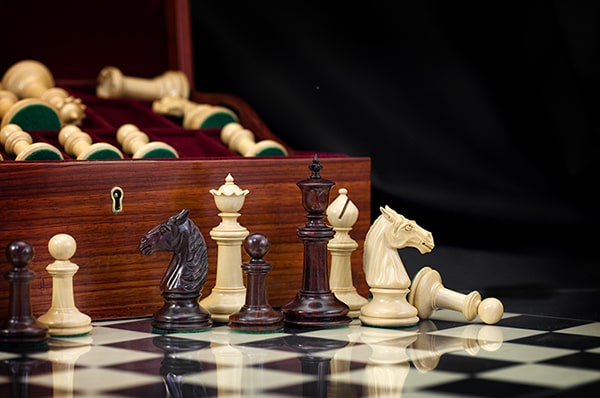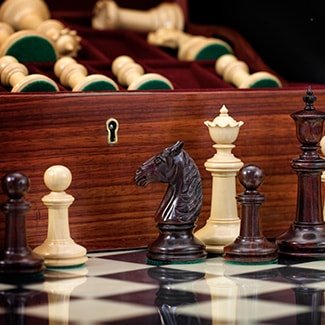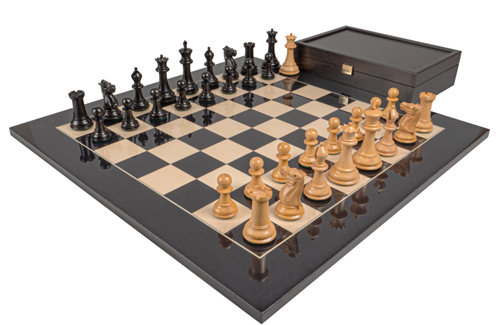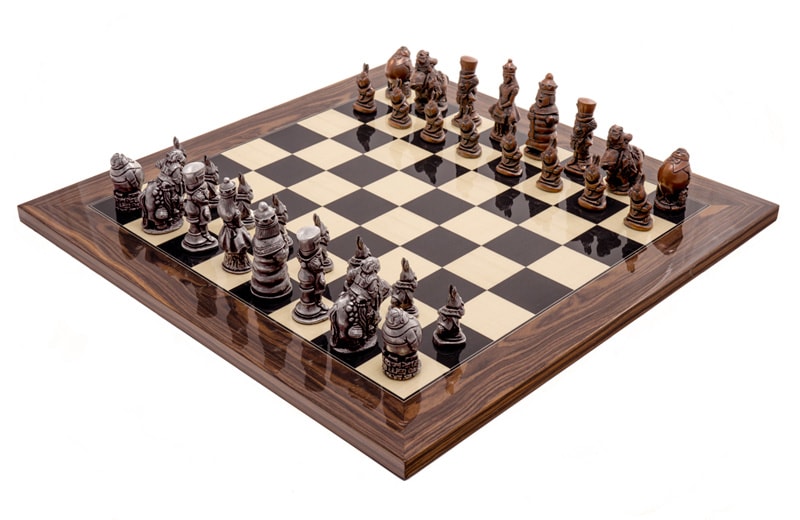[email protected] 1-833-852-1467
Established 2008

Chess Sets

TAX FREE SHOPPING!
On orders under $800

FREE SHIPPING!
On orders over $200
Chess sets are a fascinating subject and one that is obviously dear to our hearts. In India during the middle ages, the game of Shatranj was popular, and it is thought that this game was a precursor to chess. The game pieces used in Shatranj have only very vague similarities to chess pieces, and it wasn't until the game of chess was created in the twelfth century that the first chess sets came into being.
Most of the earliest versions of the ancient chess sets seem to date around the twelfth century. There is much debate about where and when chess originated, but the first chess sets seem to have come about during this time, and there is a consensus that India was the place of origin.
Chess Set design and evolution
The design of the pieces is something that is of intense interest. From the twelfth century until the mid-nineteenth century, there has been a plethora of chess set designs, some very plain and functional, others opulent, highly decorative, and expensive. Different cultures and societies all have their own versions of the chess set, and while the number of pieces and the rules of the game remained largely consistent, the pieces varied hugely. It was usual to see the design of the pieces follow cultural trends of the era, and the architecture of local buildings was always a significant influence on the design of the pieces.
The basics of any chess set is always a flat board with 64 squares and 32 pieces, a king and queen on each side, eight pawns per side, and flanking pairs of rooks, bishops, and knights for each side. Interestingly, there has been minimal traction of any alternative versions of chess that deviate from this formula. The rules of chess have remained unchanged this whole time!
Staunton Chess Sets
The world of chess sets changed forever in the mid-1800s when Howard Staunton, one of the world's greatest players of the time, happened across a new design of chessmen from the Jacques Games company. The set was quite literally a game-changer! Staunton had already been writing and complaining about the various chess set designs he was forced to use as he toured the world defending his chess titles. A set in Russia was completely different from one in France and had no consistency. He felt that the player who was already very familiar with the set had an advantage over the one that wasn't. Staunton was convinced that the set could affect the outcome of the game!
The Jacques chess set that Staunton endorsed and put his name on was a design classic that, in terms of playing chess, was the perfect set. While it had taken design nods from British architecture, it was not associated with any nation or culture, each piece looked totally different from the others, and it was impossible to mistake one piece for another. Players could recognize the pieces in an instant. Despite this, it was clear that all thirty-two pieces were from the same family. Even better was that the design of the sets meant they could be mass-produced easily, with all but the Knights being produced on a lathe machine.
This meant that chess players worldwide could have access to these new chessmen, and tournaments across the globe could all have standardized sets. Thankfully it seemed the chess community agreed with Staunton's consensus, and without much resistance, the set was quickly adopted as a global standard.
There have, of course, been variations on the design. In fact, no sooner had the copyright run out on Jacque's design did numerous companies start making their own versions. Today there has never been a rival to the Staunton Chess Set, which remains the global gold standard of chess sets.
Materials used for chess set production
Since their inception back in the twelfth century, chess sets have been made from a variety of materials. Stone, wood, bone, glass, crystal, marble, metal, and plastic have all been used. Different cultures would have crafted sets from varying materials depending on the available tools, raw materials, and skills. Today the most common material for what we would classify as a 'proper chess set' is wood. Wood lends itself to both chess pieces and chess board production. The sets are generally crafted from hardwoods such as boxwood, ebony, walnut, and rosewood, but thanks in part to export restrictions on many exotic hardwoods, a selection of new and varied woods are now finding their way into chess set production.
Wooden chess sets
The wood used in chess set production is becoming a controversial subject. In the 1800s, dense hardwood like Ebony and Boxwood were typically used to make chess pieces. At the time, wood was cheap and abundant, and no consideration was given to deforestation. An ebony tree may take a hundred years to reach maturity, so no sustainable source exists. Today Ebony chess sets remain available at a premium which keeps going up as the price of the wood rises. The recent tightening of import restrictions with other hardwoods such as sheesham, rosewood, and boxwood has meant that the chess set industry has been making the switch over to woods like Acacia and Anjan.
Woods used in the production of chess sets
- Boxwood (Buxus)
- Ebony (Diospyros ebenum)
- Sheesham (Dalbergia sissoo)
- Rosewood (Genus Dalbergia)
- Walnut (Jugans)
- Mahogany (Swietenia macrophylla)
- Wenge (Millettia laurentii)
- Palisander (a form of Genus Dalbergia)
- Maple (Acer)
- Briarwood (Erica arborea)
- Birch (Betua)
The Isle of Lewis chess set
A few years before the Staunton chess set had been created, an amazing discovery was made on the Isle of Lewis in Scotland. In what turns out to be a lovely story, a farmer who was chasing an escaped cow happened across a large chest that had been revealed when a sand bank collapsed. Inside the chest were seventy-nine twelfth-century Nordic game pieces. It's worth noting that the pieces were not necessarily a chess set, seventy-nine pieces is too many.
The amazing figures became legends in their own right, and the Lewis chess set has become a mainstay in the world of chess. While the Lewis sets have never been used for high-level chess tournaments or academic chess, they remain the second most recognized set after Staunton.
It's amazing to think how a game that originated nine hundred year ago is still alive and well today. Chess is, without doubt, the most famous, most played, and most recognizable board game in the history of civilization. The chess set is therefore an iconic piece of human history that spans nations, periods of history, and civilisations. The evolution of the humble chess set has been quite a journey, and we're delighted to be playing our part in supplying the world's finest sets to customers all over the United States.
Chess Sets With Board
All of our chess sets are available with boards as a complete set. While we do sell all of our chess pieces and board as separate products, we have combined all of our chessmen with the most ideal boards to create the perfect set. We spend many hours selecting the perfect board partner for the chessmen taking into consideration size, wood type, colour, finish and price. This makes it far easier to choose your perfect chess set. You will know how well the pieces match the board before it’s arrived at your home. We take all the guess work out so you can concentrate on playing chess.

SAVE
20%
Save 20% on your first order by using code:
Continue Shopping

















